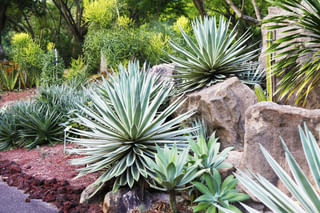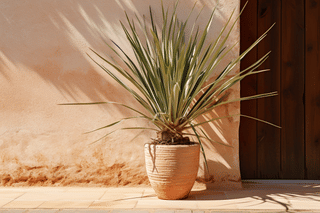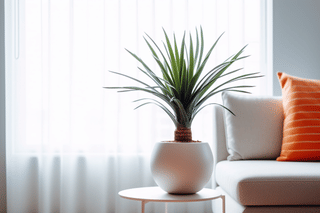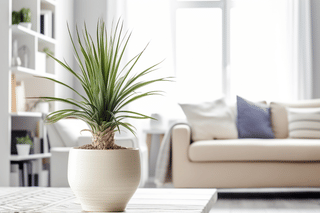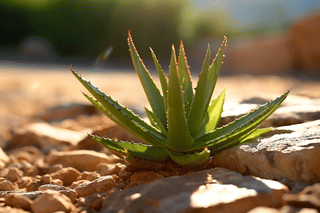How do you take care of a Yucca?
Discover the secret to keeping a Yucca plant healthy and thriving! From preventing pests to trimming dead leaves, this plant care guide covers everything you need to know. Say goodbye to wilted Yuccas and hello to lush, vibrant greenery!
Have you ever seen a plant that stands tall and sturdy, no matter how hot the sun gets or how dry the soil is? The Yucca plant is one of those plants that survive the harsh, dry, climates where it gets bright sun and barely any water. It's a perfect plant for your brightest room, is very low-maintenance, and will bring a large piece of greenery into your house.
What makes the yucca plant so special? How do we take care of it and help it grow? And, did you know there's more than one kind of yucca plant? In this plant care guide, I'll answer all these questions and more. I'll show you how to help your yucca plant be the happiest and healthiest it can be, whether it lives in your bedroom, your garden, or even if it's a tiny plant cutting just starting to grow.
These are the topics we're going to look at together:
Are you ready to become a yucca plant owner? Let's go on this exciting journey together!
What is a yucca plant?
A Yucca is a bit of a confusing plant when you're first looking at it. Is it a dracaena? And how does it relate to potatoes?
First of all, you might have heard of "Yuca" before and you might be wondering if it's the same thing as the Yucca plant. A yuca is a root vegetable, much like a potato, and has nothing to do with the Yucca plant. That's a fun fact you can share with anyone who might be confused about the name in the future.
A Yucca plant is also not the same as a Dracaena. Yucca's have sturdy, thick stems and tough, sword-like leaves that come out of that thick woody stem. A Dracaena has a much thinner stem and soft, flexible leaves.
Yucca is native to the dry environments in the Americas and even part of the Caribbean. Their shape and size are perfectly adapted to survive in these dry environments.
The most interesting fact about the Yucca plant is that it can grow flowers. You'd expect a plant that's designed to survive to be boring, but this plant is both tough and beautiful.
Watering a Yucca
So how do you water a plant that thrives in dry areas and prefers to grow in dry soil most of the time?
To water a Yucca properly and help it thrive in your house or garden, you'll need to make sure you don't water it very often. Before watering this plant, you'll need to make sure the soil is completely dry. Most plants prefer the top inch of the soil to dry out before you water it again, but the Yucca is not one of those plants. This plant needs to completely dry out before you water it again, much like a succulent or cactus.
You can check if the soil has completely dry out by lifting the pot and feeling the weight of the plant. This might take a bit of practice in the beginning though. If the pot feels light, it's time to water the plant thoroughly.
When you water your Yucca, you should water it deeply, because the soil will most likely be completely dry. This dry soil might not absorb the water right away, so make sure to keep watering the plant until it starts to absorb the water.
As soon as the soil starts to absorb the moisture, water until the excess moisture drips out of the drainage hole in the pot. When it does this, let the moisture drain for about 5 minutes and you'll have watered your Yucca perfectly.
Now you can wait for 2 weeks unless the soil has completely dried out before that time before you'll need to water your plant again.
How do you tell the difference between overwatering and underwatering a yucca plant?
The Yucca plant thrives when it's growing in a dry environment, but even the toughest plants can get too little water sometimes. So how do you recognize the signs that your yucca isn't getting enough water?
- Brown, crispy tips: The tips of your yucca plant's leaves might turn brown and crispy. This is a common sign that your plant is thirsty and needs more water.
- Wilting or drooping leaves: Underwatered yucca plants might have leaves that look wilted or start to droop down.
- Slow growth or no growth: If your yucca plant isn't growing or seems to be growing very slowly, it might need more water.
Watering your yucca too little is less common than watering it too much. So how do you recognize the signs that your yucca is getting too much water?
- Yellow leaves: The leaves of your yucca plant might start to turn yellow. This is often one of the first signs of overwatering.
- Root rot: Over time, overwatering can lead to root rot. You might notice a musty smell coming from the soil or see black, mushy roots if you take the plant out of its pot.
- Soft, mushy trunk: If the trunk of your yucca plant starts to feel soft and squishy, that's another sign of overwatering and potential root rot.
When you notice any of these signs, adjust your plant care routine to help your yuca recover. Don't move your plant or make any dramatic changes as this could shock the plant. Just water your plant or wait to water it a little longer.
In case of root rot, make sure to trim any rotting roots and repot your plant if needed.
Sunlight requirements for a Yucca
We now know that the yucca thrives in a dry environment, but how much light does your yucca need?
Most Yuccas prefer bright, indirect light. This means placing them near a window with thin curtains or blinds so that they get plenty of natural light without being exposed to direct sun rays. If this isn't possible, try using artificial lighting such as LED grow lights to help give your plant a bit of extra sunlight. You should also rotate your Yucca regularly so it gets even exposure on all sides.
If you live in an area with very hot summers, then too much sunlight can damage your Yucca's leaves and stems, causing them to burn or turn yellow. In these cases, it's best to move the plant further away from windows during peak hours of sunshine. Direct sunlight in the early morning and late afternoon and early evening is completely fine though.
Temperature ranges for a Yucca
In their native environment, the yucca gets a large range of different temperatures. During the day the temperature goes above 32℃ (90℉) and during the night the temperatures could go below freezing.
Because your yucca can tolerate such a wide range of temperatures, you don't have to worry about adjusting your living spaces to make the yucca feel right at home. It'll like the constant moderate temperatures during the day.
Ideal soil for a Yucca
If you've taken care of succulents and cacti, plants that grow in the same areas as the Yucca plant, you'll know that their soil is very low in organic material and contains lots of sand and rocks.
Your yucca doesn't need a lot to grow in. It prefers soil that contains lots of coarse sand and perlite to drain any moisture to the bottom of the pot, away from the roots, as quickly as possible.
This type of soil doesn't hold onto very much moisture, which is perfect to prevent overwatering your yucca.
If you're looking to repot your plant soon, you could pick up a bag of succulent or cactus soil to use for your yucca. If you prefer to mix the soil yourself, you can use these proportions for a great mixture: 1/3 general potting soil, 1/3 coarse sand, and 1/3 perlite. This mixture will drain most of the moisture to the bottom of the pot right away and also let oxygen reach your Yucca roots easily.
This mixture helps to prevent root rot and makes the plant feel right at home.
Feeding Your Yucca
Feeding your Yucca plant is an important part of keeping it healthy and growing.
Most Yuccas only need to be fertilized a couple of times a year, during the spring and summer months. It's best not to feed it in the winter when it's dormant and not actively growing.
When you do feed your yucca, use a balanced liquid fertilizer at half strength for cacti or succulents. This type of fertilizer contains the right mix of nitrogen, phosphorus, and potassium that your yucca needs to stay healthy and strong.
Be careful not to over-fertilize as too much fertilizer can burn the roots and leaves of your plant. Too little won't give your yucca enough nutrients to thrive, so aim for moderate portions instead. If you don't have access to a liquid fertilizer, there are slow-release pellets available that dissolve over time in the soil providing nutrition slowly over weeks or months.
To make sure you're feeding your yucca correctly, always check with local gardeners or with a professional horticulturist before applying any type of fertilizer to your plant.
Always apply the fertilizer directly to the soil and avoid bringing it in contact with your plant's leaves.
Health Troubles: Reviving Your Yucca Plant
Plant troubles happen to anyone, so you might be dealing with some issues right now. These are some of the signs that your plant is in trouble and how you can help to revive your yucca.
Reviving a dying yucca plant is possible if you catch the problem early enough. There are several signs that your plant is struggling, such as yellow or wilted leaves and discolored stems or even black and brown spots on its leaves. If you notice any of these issues, there are steps you can take to save your yucca.
First, check the soil. If it's too dry or too wet, adjust the watering schedule accordingly. Yuccas need a lot of sunlight, so make sure they're getting 6-8 hours of bright indirect sunlight per day. Repotting in fresh soil with adequate drainage may also help revive a dying plant.
If over-fertilizing is the issue (the leaves are turning a bronze color), flush the soil with water to remove any excess fertilizer salts and repot in fresh soil according to the instructions above. If repotting doesn't help, consider pruning away dead or damaged leaves and stems to encourage new growth and promote better health overall.
Finally, make sure your yucca isn't getting too much direct sunlight during peak hours (noon to late afternoon). To prevent sunburns or discoloration from prolonged exposure, move your yucca further away from windows when necessary or provide some shade during the hottest parts of the day.
Size and Growth
Yucca plants can vary in size from the smaller types, such as the Yucca elephantipes, which reach a maximum height of around 5 feet (1.5 meters), to the larger varieties like Yucca rostrata (Big Bend Yucca), which can grow up to 15 feet (4.5 meters).
The average yucca plant grows at a moderate rate and requires little maintenance aside from occasional pruning or trimming to maintain its desired shape or size. With proper care, your Yucca could live for many years and provide an attractive addition to any indoor space.
One way to control the size and spread of a Yucca is to regularly prune or trim the plant. Pruning can help keep your Yucca from growing too tall or wide. It is important to use sharp shears when pruning, as this will help you avoid leaving ragged edges that could lead to further damage.
Another great way to stop the Yucca growth is to keep it in a smaller container where it can no longer expand its roots. If your Yucca is becoming rootbound, you can trim the roots and keep the plant in the same pot. New roots will grow and your plant won't be rootbound for a year or so.
Finally, you can also limit your Yucca's growth by controlling how much sunlight it receives throughout the day. If you expose your Yucca to less sunlight, it'll also start to grow less quickly.
Propagating Yucca
Propagating a yucca plant is relatively easy and gives you the chance to create multiple plants from one. The best time of year to propagate your yucca is in the early spring when your plants start to grow again.
The easiest way to propagate a yucca is to remove the offsets from the base of the plant with a sharp knife. After you've removed these cuttings, you should let them dry out in a bright spot for 1-2 days so a callus can form on the part that you've cut. This will prevent pests from getting to your new cutting when you plant it in a new pot.
When you've waited 1-2 days after removing the cuttings from the parent plant, you can plant the cuttings in a small pot with well-draining, sandy soil and water it thoroughly. Make sure to let the excess moisture drain from the pot.
After a few weeks, you should start to see new roots appear and you'll have successfully propagated your yucca.
Maintaining Your Yucca: Trimming and Repotting
Taking care of a yucca houseplant requires regular trimming and repotting to keep it healthy. Trimming your yucca plant helps keep its shape, encourages growth, and prevents pests from taking hold in the foliage.
To trim a yucca, use sharp shears or scissors to prune away any dead or damaged leaves and stems. You can also remove any offshoots that appear at the base of the stem if you want to contain its size.
Make sure not to remove too much foliage since this could cause shock or damage the plant's health. When finished with trimming, use fertilizer according to the instructions on the package for best results.
Repotting is also important for keeping your Yucca healthy as it allows you to replenish the soil and give your plant more room to grow. You should repot your yucca every two to three years when the plant has outgrown its current pot. When it's time to repot your yucca, choose a new pot that is one size up from its current pot.
When repotting your yucca, take care not to disturb the roots too much as this can cause shock or damage the plant's health. Make sure that you don't bury the stem too deeply as well since this can also cause health issues for your yucca.
Once potted, it's important to keep an eye on your plant for any signs of shock such as wilting leaves or discoloration of foliage. If you notice these signs, move your Yucca to a shadier spot and reduce watering until it recovers.
Yucca Indoors Vs Outdoors
At the beginning of this plant care guide, I mentioned that you can also grow a Yucca outdoors. But when can you bring your Yucca outdoors? Let's find out!
You can grow Yucca plants both indoors and outdoors. Many Yucca varieties are well-suited for outdoor gardening. When you're looking into whether to keep a Yucca indoors or outdoors, it's important to consider its needs and if that works with the climate where you live.
Generally speaking, outdoor Yuccas need full sun and thrive in warm, dry climates with good drainage and low humidity. If you live in a region that is too cold for your outdoor Yucca plant or has excessive rain or snowfall, you'll have to keep your plant indoors and you, unfortunately, can't grow it outdoors.
If you live in a climate where the temperatures stay above freezing in the winter and it stays dry, you can even keep your Yucca outside in the winter. However, if you get a lot of snow or the temperatures drop below freezing, you should move your Yucca indoors during this time of year. Your Yucca is a very tough plant, but it does have limits.
Yucca and Your Pets: A Toxicity Guide
If you're a pet owner, it can be tough to find plants that are harmless to your furry friends. Unfortunately, Yucca plants are toxic to cats and dogs if ingested. The compounds in the plant can cause gastrointestinal problems such as vomiting or diarrhea in animals. If your pet has eaten part of a yucca plant, it is important to contact your veterinarian for advice and guidance.
If you have well-behaved pets that don't take any interest in eating your plants, you can choose to bring this plant into your home. If you do bring this plant home, be extra careful and ideally only keep this plant in rooms where your pets won't or can't go.
I'm lucky enough to have cats that don't eat plants, but an accident is always a sniff or bite away, so take the extra precaution to protect both your pets and your plants.
Yucca Lookalikes: From Dracaena to Cordyline
In the introduction of this plant care guide I've already mentioned that the Yucca looks a lot like a Dracaena, but are there other plants that look similar to a yucca?
Besides a Dracaena, you've got a Cordyline, an Agave plant, and an Aloe vera that looks like a Yucca.
You can tell the difference between an Agave and a Yucca by looking at the stem of the plant. The Yucca has a woody tree-like trunk out of which grow tough leaves. The Agave plant grows these leaves from a thick, but small trunk that's close to the ground. Often, you won't even see the Agave trunk and it'll look like the leaves grow from the soil.
You can tell the difference between a Cordyline and a Yucca by looking at the colors of the leaves. A cordyline has much more dynamic leaf colors, going from purple to red, to bright green. Its leaves are also much more flexible than the Yucca's leaves.
And last but not least, you can tell an Aloe vera and a Yucca apart by looking at the leaves. The Aloe Vera has thick, fleshy leaves with "teeth", while a Yucca has thinner, sword-like leaves with smooth edges.
Thank you for reading this post! I hope it helps you to keep your plants healthy and beautiful! If you're looking for more guides on specific plants, you can always request a plant guide to get a guide for the plant you have trouble with.
Test your plant care knowledge
Quiz completed!
Want to learn more? Sign up for my newsletter to receive free tips in your inbox!
Sign up now!